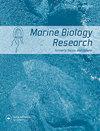栖息在日本北海道南部海岸的太平洋鳕鱼的夏季饮食和喂养策略
IF 1.2
4区 生物学
Q4 ECOLOGY
引用次数: 0
摘要
摘要基于2016–2020年6月下旬至7月初在北海道南部海岸用拖网收集的1302份样本,研究了太平洋鳕鱼(Gadus macrochalus)在饮食和喂养策略方面的个体发生和年际变化。饮食包括63种(13个分类群)。鱼类是最重要的猎物,其次是十足目甲壳类动物。2016年,walleye pollock(Gadus challgrammamus)是主要的鱼类猎物,而片脚类、十足类和日本灯笼鱼(Notoscopellus japonicus)在2017年的饮食中尤为突出。日本沙丁鱼(Sardinos melanostictus)在2018-2020年期间占主导地位。饮食的个体遗传学比较表明,较小的个体(≤400 mm标准长度,SL)主要捕食小型猎物,如十足目甲壳类动物和多毛类,而体型较大的个体(>400 mm SL)主要捕食鱼类。此外,猎物的体型随着捕食者的体长呈显著增加趋势。这些结果表明,太平洋鳕鱼有一种灵活的喂养策略,因生活阶段而异。本文提供的关于捕食者-猎物关系的最新信息提高了我们对海洋生态系统中能量流动的理解,并有助于制定基于生态系统的渔业管理战略。本文章由计算机程序翻译,如有差异,请以英文原文为准。
Summer diet and feeding strategy of Pacific cod (Gadus macrocephalus) inhabiting the southern coast of Hokkaido, Japan
ABSTRACT The ontogenetic and interannual variations in the diet and feeding strategy of Pacific cod (Gadus macrocephalus) were examined based on 1302 specimens collected by a trawling net off the southern coast of Hokkaido from late June to early July during 2016–2020. The diet comprised 63 species (13 taxa). Fish was the most important prey, followed by decapod crustaceans. In 2016, walleye pollock (Gadus chalcogrammus) was the dominant fish prey species, while amphipods, decapods and Japanese lanternfish (Notoscopelus japonicus) were prominent in the diet in 2017. Japanese sardine (Sardinops melanostictus) were more predominant during 2018–2020. An ontogenetic comparison of diet indicated that smaller individuals (≤400 mm standard length, SL) preyed mainly on small prey items, such as decapod crustaceans and polychaetes, whereas larger individuals (>400 mm SL) preyed mainly on fish. Moreover, prey size exhibited a significant increasing trend with predator body length. These results suggest that Pacific cod has a flexible feeding strategy that differs by life stage. The updated information on predator–prey relationships provided herein improves our understanding of energy flow in the marine ecosystem and could facilitate ecosystem-based fishery management strategies.
求助全文
通过发布文献求助,成功后即可免费获取论文全文。
去求助
来源期刊

Marine Biology Research
生物-海洋与淡水生物学
CiteScore
2.10
自引率
0.00%
发文量
55
审稿时长
6-12 weeks
期刊介绍:
Marine Biology Research (MBRJ) provides a worldwide forum for key information, ideas and discussion on all areas of marine biology and biological oceanography. Founded in 2005 as a merger of two Scandinavian journals, Sarsia and Ophelia, MBRJ is based today at the Institute of Marine Research, Bergen, Norway. The Journal’s scope encompasses basic and applied research from all oceans and marine habitats and on all marine organisms, the main criterium for acceptance being quality.
 求助内容:
求助内容: 应助结果提醒方式:
应助结果提醒方式:


